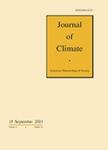版权所有:内蒙古大学图书馆 技术提供:维普资讯• 智图
内蒙古自治区呼和浩特市赛罕区大学西街235号 邮编: 010021

作者机构:Danish Meteorol Inst Lyngbyvej 100 DK-2100 Copenhagen O Denmark
出 版 物:《JOURNAL OF CLIMATE》 (气候杂志)
年 卷 期:2015年第28卷第24期
页 面:9873-9891页
核心收录:
学科分类:07[理学] 070601[理学-气象学] 0706[理学-大气科学]
基 金:EUCLEIA project - European Union's Seventh Framework Programme (FP7)
主 题:Physical Meteorology and Climatology Climate variability Observational techniques and algorithms Climate records Mathematical and statistical techniques Risk assessment Statistical techniques Time series
摘 要:In attempts to attribute a single eventsuch as an observed heat wave or floodingto climate change, the probability distributions of the quantity under consideration for current and preindustrial conditions are compared to determine a possible changed occurrence rate. These distributions are typically calculated from large ensembles produced by climate models and require large computational resources. In this study, a simple alternative surrogate method together with analytical considerations will be used as a test bed to inform about methodological issues connected to the selection problem and deviations from Gaussianity that should be considered before comprehensive climate models are *** author will mainly study the influence of the selection problem, which in this context means that when an event has been observed it is not obvious how the probability distributions should be defined. Should similar events be looked for in the immediate neighborhood of the observation or in an extended area? It is shown that this choice will have serious consequences for the distributions of the events and the attribution to climate *** author also demonstrates that deviations from Gaussianity can have a large influence on the conclusions and that it is important that the ensembles adequately represent the features that contribute to the extreme events under consideration. In particular, it is shown that the fractional attributable risk has very different behavior for heavy-tailed distributions than for Gaussian distributions. In the example considered with the surrogate methodEuropean heat wavesimportant features also include the seasonal variation in skewness.